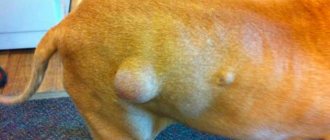Causes of the disease
Myositis is an inflammatory process in the dog's muscle tissue. The causes of myositis may be:
- hypothermia;
- viral infections;
- elderly age;
- obesity;
- allergy;
- weak immunity;
- excessive physical activity;
- training an unprepared dog, muscle injury (strain, tear);
- untreated muscle wounds (infection).
Myositis – what is it?
Myositis is diagnosed in dogs when the inflammatory process affects muscle fibers. This disease comes in several types: eosinophilic, traumatic and rheumatic. A common cause of this pathology is regular jumping and running on uneven surfaces. During such movements, the muscles that perform the function of flexion are stretched. Less commonly, ruptures of fibers and even blood vessels can occur, which leads to hemorrhages. Myositis can occur in both chronic and acute forms.
Which breeds are more susceptible
At risk are those dog breeds that, due to their purpose, have increased loads - these are working dogs - herding, hunting, service breeds.
During an active long run, the muscles, having received a load, produce lactic acid, an excess of which can lead to injuries to the muscles of the shoulder, hips, lower back, back and neck, and hypothermia will only accelerate the development of the disease.
It is necessary to understand that any pet is susceptible to a dangerous disease. When a dog is exposed to the rain for a long time, swimming in cool water, or just walking after a bath - all these factors lead to hypothermia of the pet with the risk of developing myositis.
Symptoms
Myositis is not only an acute and chronic disease, but also very unpleasant. Pain causes dogs to whine constantly and feel generally unwell. Even after treatment, relapses often occur - new healthy muscles also begin to hurt. As a rule, the first signs of the disease appear in the shoulder and pelvic regions , since this is where the most active muscles are located. At the beginning of the disease, the animal feels physical fatigue only after a night's sleep; with further development of the disease, symptoms appear throughout the day.
Main symptoms
Myositis in dogs is divided into several types (depending on the causes) with characteristic symptoms:
- Traumatic - loss of appetite, lethargy, the dog’s movements are careful, the animal takes care of the damaged area, when palpated, a dense area in the sore muscle can be identified, burdened by a tumor and elevated temperature.
- Purulent (infectious) is the consequences of an untreated injury to a dog’s muscle, which causes the process of suppuration, an increase in temperature, the animal is lethargic and inactive, and there is no appetite.
- Rheumatic - affects the muscles of the back and lower back. The animal characteristically hunches over and has difficulty going to the toilet, the pet has difficulty getting up on its paws, does not allow touching the sore spot, and shows nervousness.
With any type of myositis, the dog experiences severe pain in the muscle tissue, has difficulty moving, is depressed and practically does not eat.
Along with the described types of myositis, cases of damage to the chewing muscles of dogs (deterioration of jaw mobility, convulsions) have been recorded. For this pathology, the term eosinophilic myositis is used, but the mechanism of its origin and development is not fully understood.
Each type of myositis is treated differently, which is why it is so important to diagnose the pathology using modern methods used in veterinary clinics.
Symptoms of myositis in dogs
An owner can suspect the development of a pathological process in the skeletal muscles of pets by knowing the clinical picture of the disease:
- Stiffness in movements. Most often in the morning, household members note that the dog is not active after sleep - it is difficult for him to get up from the lounger, he is reluctant to go for a walk. The movements are not so cheerful and energetic.
- If a dog has developed neck myositis, then it stops responding to a name by turning its head.
- On the street, the animal does not show its former activity - does not play its favorite games, does not run or jump.
- The owner can suspect that the dog has muscle pain by its reaction to stroking. The animal tries to move away from the hand and squeals when there is intense movement. A sweet and affectionate dog may even snap and bare his teeth due to the pain caused.
- During a walk, the owner can observe that the pet has difficulty defecating and even urinating. This occurs if a large array of muscles is subjected to inflammation, for example the skeletal muscles of the hip joint.
- If a dog develops eosinophilic myositis, which affects the masticatory muscles, there is a sharp decrease in appetite or a complete refusal to eat.
- Upon palpation, inflamed muscles may be hot to the touch, and swelling and swelling can be seen in the area of pathology.
- With the development of purulent myositis, the animal experiences depression, refusal of food, and an increase in general temperature.
Diagnostics in a veterinary clinic
Myositis is an insidious disease. Within a few days, it turns your beloved pet into a sedentary, nervous, suffering animal.
At the first symptoms of limited movement, difficulty toileting or loss of appetite, you should contact a veterinary clinic for a comprehensive examination and diagnosis of the problem.
The sooner a specialist examines you and prescribes treatment, the easier the path to recovery will be.
Diagnostics usually includes a full examination of the body: examination and palpation of the diseased area, a general blood test, ultrasound examination to detect ruptures, swelling, Dopplerography to assess the condition of the vessels supplying the affected muscle, Voll diagnostics to clarify the preservation of the connection between muscle tissue and nerves, X-ray and MRI prescribed according to indications.
If the dog’s movements are difficult or it experiences pain when the muscles are strained, then there can be no question of living a full life. To combat an illness, you should never rely on your own strength or self-medicate. Only a specialist will be able to determine the type of pathology and prescribe effective treatment.
Rheumatic myositis
This type of myositis has an infectious-allergic etiology; during the course of the disease, neurodystrophic processes occur in the connective tissues of the muscles. It can occur in both acute and chronic forms.
On the subject: To relieve convulsive spasms you need to stretch the muscles of the foot
The exact causes of rheumatic myositis have not yet been identified, but there are signs of an allergic and infectious (against the background of hemolytic streptococci) nature.
Among the factors predisposing to the development of the disease are the following:
- frequent and prolonged colds;
- sudden hypothermia of the body (swimming in ponds, exposure to rain, often dogs become hypothermic when they run away from their owners and wander for a long time, walking after taking a bath);
- tendency to allergic reactions;
- advanced age;
- obesity;
- weak immune system.
Most often, working dogs of hunting and herding breeds suffer from rheumatic myositis. The disease is always accompanied by pain in the damaged muscles. Dogs suffering from myositis try to move less, whine and yelp when touched. It is difficult for pets to rise from a lying position; when walking, it is noticeable that they are tense.
It is difficult for your pet to defecate; he may moan at this time, and sometimes he cannot go to the toilet at all. If the lesion affects only some muscle groups, then the signs of myositis are less pronounced.
The muscles of the lumbar region and back are most often affected by the rheumatic type of disease. Any, even the most insignificant movement, in this case, is extremely painful, and the animal appears noticeably hunched over.
When rheumatoid damage spreads, the cervical and occipital regions are involved. In such a situation, it is very difficult for the dog to eat food, since due to the pain syndrome, it can neither raise nor lower its head. And, in addition, rheumatism can also affect the muscles responsible for chewing processes, then the pet will not be able to eat at all. When the muscles of the limbs are damaged, the animal begins to limp.
When palpating the location of the disease, you can feel muscle tension and swelling; at this moment the pet feels severe pain.
With an exacerbation of rheumatic myositis, a sharp increase in temperature can be observed; in severe cases, pain can move from one muscle group to another. Against the background of a chronic illness, muscle atrophy occurs.
Treatment of the disease is complex:
- If the dog is kept on a chain or in an enclosure, it is necessary to place it in a warm room.
- To eliminate the pathogenic B-hemolytic bacterium streptococcus, antibiotic therapy is used intramuscularly (Penicillin, Bicillin-3, etc.). For a positive effect, a loading dose is calculated.
- For internal use, drugs with a specific antirheumatic effect are prescribed - Brufen, Butadione, sodium salicylic acid.
- To relieve pain, Analgin injections are given (subcutaneously or intramuscularly).
- An effective procedure in this case is blood transfusion (the blood must be stabilized with sodium salicylate);
- Therapy is often supplemented with glucocorticoids.
The following procedures also give positive results: UHF, light irradiation, therapeutic massage. It is useful to rub the affected muscles with irritating liniment. For the same purposes, you can prepare a special mixture of bleached and camphor oil, salicylic acid and methyl ester. The use of this method followed by wrapping provides effective pain relief.
Source
Treatment method and prognosis
To treat and restore your dog, you must follow all doctor's instructions. This will help your pet recover and prevent muscle atrophy. For mild forms and timely visit to the clinic, treatment takes from 3 to 15 days.
When treating all types of myositis, it is important to ensure complete rest of the animal with the exception of unnecessary physical activity. The animal should be placed warmly on soft bedding without drafts.
Rheumatic inflammation is treated with drugs with antirheumatic effects, which should be selected by a doctor.
For purulent myositis, the damaged tissue may be excised and antibiotics may be prescribed.
If your pet has severe pain, the doctor will add painkillers to the therapy, having previously analyzed the animal’s health problems to exclude complications. Based on the general condition of the sick animal, compresses and physiotherapy may be prescribed.
When pain disappears, it is useful to massage to speed up muscle recovery.
Unfortunately, in advanced cases or complicated by the pet’s general health, drug treatment may not bring relief, then a decision is made to perform surgical intervention.
No effective regimens have yet been developed for the treatment of myositis of the masticatory muscles in dogs. In most cases, hormonal drugs, blood replacement fluids and compresses are prescribed. This treatment helps maintain the normal condition of the pet, but you should not count on a complete recovery.
Treatment
Myositis of the cheekbone muscles in dogs is the most difficult to treat. In most cases, it is not possible to completely get rid of it. When prescribing medications and methods of therapy, it is important to know the reason that provoked the pathology. You shouldn't rely on your own strength. The animal must be examined in a specialized clinic. Only there will the correct diagnosis be made, thanks to which it is possible to choose effective treatment. For example, for rheumatic inflammation, it is necessary to take special medications that have an antirheumatic effect. Analgin injections, compresses and physiotherapy are added to the course of therapy. If there is no pain, then you can perform a massage that will help restore the function of muscle tissue. Sometimes drug treatment does not bring positive results, so the doctor may decide to perform surgery.
What to do at home
Myositis in dogs is a disease in which the muscles become inflamed. During the treatment period, the animal should have a warm, soft place and good nutrition. This mandatory addition to drug treatment helps the body weakened by the disease to gain strength for recovery.
It is important to create a favorable psychological climate around the pet: the dog should be in a state of absolute calm. You need to talk to her, not forgetting that the animal is good at feeling the mood and intonation of a person.
Depending on the damage to the muscles, it is difficult for the animal to move, so the pet must be sure that even to change its position, a caring owner will come to the rescue. You need to know that lying down for a long time can cause bedsores.
By providing attention and assistance to the dog, the owner demonstrates how dear the pet is to him. Only together, only through joint efforts can we defeat the disease.
Features of the disease
Myositis in dogs is an insidious disease. After all, even living in a city apartment, an animal needs to constantly move. And if his muscles become inflamed, this will be quite problematic. The dog refuses to walk and completely stops playing and running. Lying down, he periodically whines as his muscles are seized by aching pain. The dog's movements become slow. Before placing his paw, he thinks for a long time, as if deciding to do it. It takes him a long time to find a place, and in the end his movements are reduced to forced ones.
Possible complications
With self-medication and untimely referral to the clinic, inflammatory processes in the dog’s muscle tissue develop. It becomes almost impossible to stop the process without consequences and complications for the pet’s health.
Complications:
- muscle weakening to the point of death;
- spread of purulent infection to other organs;
- the size of the damaged muscle changes - it shortens;
- disruption of muscle activity.
If there is a malfunction in muscle function, the pet’s quality of life deteriorates sharply. The owner’s important task is to go to the clinic as quickly as possible and prevent complications from developing.
Diet
For inflammatory processes in the muscles, the diet is based on the principles of proper nutrition.
When examining a pet in a clinic, in addition to prescribing basic treatment, the doctor will give recommendations on the animal’s nutrition. The principles of nutrition for myositis include eating foods containing vitamins and easily digestible proteins.
- Foods rich in vitamins E, A and C include: tomatoes, sweet peppers, green salad, kiwi fruits, plums, citrus fruits, green apples with a sour taste, vegetable oil.
- Products containing a large amount of easily digestible proteins include: soy, ground beef, chicken, oysters.
It is allowed to include in the dog’s diet products containing natural substances with analgesic and anti-inflammatory properties: root vegetables of carrots, potatoes, beets, they will help restore the dog’s health.
In order to reduce inflammation, stewed or boiled fish may be useful.
It is important to include in your dog’s diet foods high in calcium (fermented milk products, currants, gooseberries, parsley and cabbage), magnesium (cereals) and zinc (liver, eggs, cheese and pumpkin).











